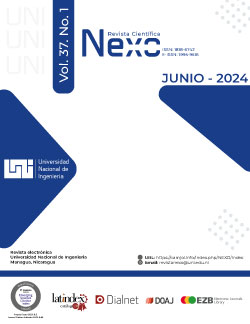A web application for post-processing seismic hazard assessment results
DOI:
https://doi.org/10.5377/nexo.v37i01.18320Keywords:
Seismic Hazard, Web Server, Uniform Hazard SpectraAbstract
A web application for post-processing of PSHA results in order to obtain a variety of maps and graphics for user-defined needs is discussed. It was developed for using the results from the R-CRISIS software main calculations, but its principles are universal and may be adapted for any other PSHA software. The process is performed in two steps: the first is to prepare files to be used as input for the web application, and the second step consists of processing these files for new results and plots (trough the execution of programs and scripts). The work is organized in a server-client scheme, where the server side has all the required software together with the results and input files from the PSHA calculation. The software is accessed through a Web-Portal on the server side. We present examples of requests and results.
Downloads
602
References
Alvarez, L. (2014). Sistema de análisis de la sismicidad sobre servidor Web. Ciencias de la Tierra y el Espacio, Vol.15, pp. 184-198.
Álvarez, L. (2022). Nueva Estimación de la Amenaza Sísmica para Nicaragua. Revista Tierra, Vol. 2, No. 1, 18 pp.
Alvarez L., Lindholm, C. and Villalón, M. (2017). Seismic Hazard for Cuba: A New Approach. Bull. Seism. Soc. Am., vol 107, pp. 229-239.
Baker, J., Bradley, B. and Stafford, P. (2021): Seismic Hazard and Risk Analysis. Cambridge University Press. 595 pp.
BSSA (2024): BSSA Special Issue on Seismic Hazard Models. Bull. Seism. Soc. Am. Vol 114(1).
Chiou, B. and Youngs, R. (2014). Update of the Chiou and Youngs NGA Model for the Average Horizontal Component of Peak Ground Motion and Response Spectra. Earthq. Spectra. Vol. 30, pp. 1117-1153.
GEM (2022). The OpenQuake-engine User Manual. Global Earthquake Model (GEM) OpenQuake Manual for Engine version 3.18.0.
Ordaz, M., Aguilar, A. and Arboleda, J. (2008): CRISIS'2007. Program for computing seismic hazard. Instituto de Ingeniería de la UNAM.
Ordaz M. and Salgado-Gálvez M.A. (2019). R-CRISIS Validation and Verification Document. ERN Technical Report. Mexico City, Mexico, 310 pp.
Ordaz, M., Mánica, M.A., Salgado-Gálvez, M.A. and Osorio, L. (2022): Inclusion of site-effects: an approach coherent with contemporary event-based PSHA practices. Soil Dyn. Earthq. Eng., Vol. 158, article 107286.
Pagani, M., Monelli, D., Weatherill, G. A. and Garcia, J. (2014). The OpenQuake-engine Book: Hazard. GlobalEarthquake Model (GEM) Technical Report 2014-08, 67 pp.
Pagani, M., Silva, V., Rao, A., Simionato, M., Johnson, K. (2023). OpenQuake Engine Manual. Release 3.16.3, 216 pp.
QGIS (2024). QGIS. A Free and Open Source Geographic Information System https://qgis.org/en/site/
Salgado‐Gálvez, M.A., Ordaz, M., Singh, S.K., Pérez‐Campos, X., Huerta, B., Bazzurro, P. and Fagà, E. (2023): A Caribbean and Central America Seismic Hazard Model for Sovereign Parametric Insurance Coverage. Bull. Seism. Soc. Am. Vol.113, pp. 1-22.
Shewchuk, J.R. (1996): “Triangle: Engineering a 2D quality mesh generator and Delaunay triangulator”, in First Workshop on Applied Computational Geometry (Philadelphia, PA), 124-133, ACM.
SRL (2024): SRL Focus Section on Seismic Hazard Models. Seism. Res. Lett., Vol 95(1).
Wessel, P. and Smith, W.H.F. (1998). New, improved version of Generic Mapping Tools released, Eos Trans. AGU 79, no. 47, 579.
Wessel, P. and Smith, W.H.F. (2019). GMT, version 4.5.18.
Williams, T. and Kelley, C. (2022). Gnuplot 5.4: An interactive plotting program.
Downloads
Published
How to Cite
Issue
Section
License

This work is licensed under a Creative Commons Attribution-NonCommercial-NoDerivatives 4.0 International License.
The authors who publish in Nexo Scientific Journal agree to the following terms:
- Authors retain the copyright and grant the journal the right of the first publication under the license Creative Commons Attribution License, which allows others to share the work with a recognition of the authorship of the work and the initial publication in Nexo Scientific Journal.
- Authors may separately establish additional agreements for the non-exclusive distribution of the version of the work published in the journal (for example, in an institutional repository or a book), with the recognition of the initial publication in Nexo Scientific Journal.
- Authors are allowed and encouraged to disseminate their works electronically (for example, in institutional repositories or in their own website) before and during the submission process, as it can lead to productive exchanges, as well as earlier and greater citation of published works.










